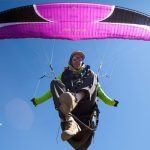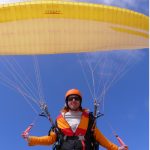Ground handling control is good for everyone!
Whether you are a novice pilot or not, by practising your paragliding ground handling control you not only will make nicer and savers takeoffs but you will improve your reactions and your feeling of the wing in flight.
It is very important after you have finished your Club Pilot paragliding course to practise your ground handling as much as you can: it is almost a flight simulator! And if you are a rusty pilot, it is the best thing you can do before you go back to the game.
Ground handling exercises for paragliding pilots
Here you have some tips for your ground handling practices with some exercises that we use in our paragliding courses for beginners and Post Club Pilot courses.
 Ideally you use the equipment what you normally use for flying; that gives you a good feeling of your harness and your glider, but if you don't want to take the risk of damaging your new wing, you can practice with an older one (it is easy to find cheap old paragliders in the second-hand market).
Ideally you use the equipment what you normally use for flying; that gives you a good feeling of your harness and your glider, but if you don't want to take the risk of damaging your new wing, you can practice with an older one (it is easy to find cheap old paragliders in the second-hand market).
For beginners, it can be useful to practice with mini-wings when the wing is strong. We always start with these mini-wings in our Elementary Pilot courses: it is easier, and the students learn faster.
Ground-handling excercises for paragliding pilots
Find a nice open space without obstacles; if you choose a landing field, you must be sure that you don't disturb pilots landing on it!
Wear a helmet, of course.

It is important that you master both technics: forward and reverse launch.
In light wind (<10 km/h), you can practice the forward launch. You can also
The wind speed should be 15-20 km/h for practising the reverse launch.
You also can practice the control of the wing when you running: the pitch and the roll.
 For the reverse launch, try to control the wing above your head as long as possible, then turn around and face forward, control the wing for a while, turn around again and collapse your wing. Restart.
For the reverse launch, try to control the wing above your head as long as possible, then turn around and face forward, control the wing for a while, turn around again and collapse your wing. Restart.
You can play a game with your friends: inflate the wings at the same time and try to keep the wing over your head as long as possible. Make several rounds... Who loses, pay the beers!
If possible, practice all this on a little hill: take off and make very small flights, then try to go back to the top of the hill kiting with the wing.
To know how to collapse your wing safely when landing in a strong wind, you can pull down the C risers at the same time that you turn around 180º and face the wing. This reduces the surface of the wing exposed to the wind and, consequently, its force. You can practice this in a moderate wind: use the reverse launch technic, turn around forward and try to collapse the wing on that way.
Control the pitch forward: for this exercise, allow the wing to search ahead of you without checking it on the brakes, and see if you can anticipate when it’s going to make a frontal collapse.















